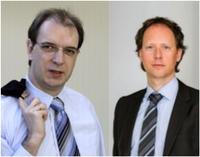It´s a long way to the top (if you wanna take control)
Strategic communication is a billion market. Year after year, companies and organizations invest a significant amount of money in public relations, customer, finance and employee communication. Until now, relatively few know how the success of these various communication activities can be measured. One particular question remains: How does successful communication contribute to achieve the objectives of the overall organization and how can you measure it?
It's less about performance review or justification. Much more important is a target-oriented management of the communication function in the interests of the company. The biggest obstacle for this is: Linking business strategies and communication in a useful way. For almost every second interviewed communication manager this belongs to the three main challenges for communication management. This is shown by the current results of the world`s largest PR survey – the European Communication Monitor.
Further challenges and personal insights were addressed by our international colleagues as part of the interviews with communicationcontrolling.de. We summarize the main points and formulate five principles for a successful linkage between communication management and communication measurement.
This article concludes the series „Thought Leaders in PR measurement” – we’ve talked to 12 people who shaped the international debate on communication measurement in various periods.
1) Link the impact of communication to organizational core processes
Even if communication professionals do not like to hear: Many decision makers from higher management levels have only a very vague idea of the importance of strategic communication for the success of the entire organization – and thus for their own achievement of objectives. Empirical studies show that top managers consider their personal communication skills as very important, but trust their communication managers less. In addition, their expectations and experiences differ markedly from those of the communicators [1].
The reasons for this are manifold, but the basics are: Communication professionals describe their performance often very diffuse and do not refer to higher-level objectives of the company. Often mentioned items are soft and communicative outcomes, such as trust, reputation, brands and images. Seen in the long term, these can become intangible values. But those cannot be evaluated in an obligatory way. Therefore, the performance of the communication should be always described for core processes of strategic and operations management. If the scope of action is secured, relationsships are established and strengthened, business processes are accelerated, costs are saved and competencies are established, the reference to organizational goals will be readily apparent. This is a fortiori true especially when cost-benefit calculations can be done. Clear objectives at the organizational level are essential if one wants to define measurable results for communication activities. Communication manager must – pointed out by James Grunig, Don Stacks, Tom Watson and David Rockland -, illustrate the value of communication per se and improve the coordination of communication and organizational goals through systematic planning processes. On both points, communication measurement helps by establishing necessary links and supplying data.
2) Listen better to target groups and adapt communication processes at an early stage
Professional communication is not only valuable because of its possibility to provide information, thematize issues and influence attitudes. Equally important is the systematic monitoring of opinion making processes and of multiplier networks with relevant stakeholders. That is nothing new. In addition to processes for the use of media, organizations also need an "architecture of listening" [2]. But PR evaluation still focuses – similar to the advertising research – on the potentials of one-way information processes. Even in the discussion about the measurement of social media communication, the discussion is very specific about metrics for ranges, followers and likes, but the benefits of environmental monitoring are usually only mentioned. At the same time, many still try to calculate financial ratios such as return on investment (RoI) of communication, even though it does not require basal conditions such as the exact identification of costs and attributable revenues. This is the wrong way. As Fraser Likely explained, the importance of formative, an accompanying, evaluation of communication processes should be more emphasized and reported. Instead of RoIs cost-benefit calculations might be useful. This seems more credible, said David Geddes.
3) Learn to understand studies and analyzes and to evaluate data
The measurement and evaluation of communication processes is not a secret art, but a daily standard practice in applied market, opinion and communication research. But PR and strategic communication still lack in experience with study design, data collection, data analysis and reporting. Even though there will be a change in these mindsets over the next few years due to current education contents and a generational change Katie Paine, it is essential for communication managers to know empirical methods and to understand (at least the apporaches of) statistical methods David Geddes. For the credibility of communication management it’s crucial that industry-specific measurement methods are based on scientific standards. Communication managers require skills to recognize that: Growing demand and competition among established service providers promote pragmatic solutions and pseudo-standards which will make incorrect statements over the long term and – if used – will mislead.
4) Use consistent terms and procure a common understanding
A consistent orientation of strategic communication toward organizational goals means that standardized evaluation methods inevitably come up against limits. In recent years, various initiatives tried to foster international standards. This ranges from the standardization of levels of analysis in the DPRG / ICV framework up to concrete measurement methods and metrics, for example for social media communication that were proposed by the Institute for Public Relations. Some international experts such as David Rockland, Sandra Macleod and Katie Paine consider them helpful. Others, such as Rainer Mathes are skeptical, especially because of the required linkage to business models that necessarily differ. Standards are not an end unto themselves. They also shouldn’t be based on a minimum consensus. Mainstream providers, for example in the field of media analysis, try to cement their market position with pseudo-standards. It`s rather about creating transparency for all involved by using consistent terminology and descriptions of methods. Necessary concepts and contents are meanwhile known – now it’s time to spread the word.
5) Think and act interdisciplinary, hike between the worlds
The development of know-how among those who are responsible for the management of strategic communication in communication departments, agencies and service companies in evaluation is and will remain the main challenge for communication measurement. Starting point is, therefore, academic education. Courses on empirical social research and specific offers for PR evaluation, for example on bachelor level and at colleges, are still too rare. Even in continuing education programs the knowledge transferred is often only limited. Not least, many communicators are lacking in interdisciplinary strategy and business knowledge which is crucial for bridging the gap between communication and top management. Sharing expertise in the field of management and evaluation is and will remain the key toward the professionalization of strategic communication – experts like Walter Lindenmann and Jim Macnamara agree on this. Inextricably linked with that is the importance of raising awareness of ethical principles in data collection and usage. Relevant findings will always have consequences and will influence the position of individual departments and decision makers. Quality and responsibility depend on each other and must be improved and developed together.
It´s a long way to the top (if you wanna take control)
The discussion on PR evaluation and communication measurement has made grand strides in recent decades [3, 4]. But it was and is a hard way full of privation – our headline freely based on the AC/DC classic from 1976 illustrates this. There is still much to do in order that communication management can benefit from the described findings. This unlocks exciting new questions and issues in the field of academic research, especially with a view on mobile media and intercultural communication. And there are numerous options for profiling in the professional field of PR – people who understand the methods are able to anchor communication in organizational contexts in a new way and gain more influence. And companies which do not master the interaction of communication management and communication measurement will be less successful.
References
[1] Zerfass, A., Bentele, G., Schwalbach, J., & Sherzada, M. (2014). Corporate Communications from the Top and from the Center: Comparing Experiences and Expectations of CEOs and Communicators. International Journal of Strategic Communication, 8 (1), forthcoming.
[2] Macnamara, J.R. (2013). Beyond voice: Audience-making and the work and architecture of listening. Continuum: Journal of Media and Cultural Studies, 27 (1), 160-175.
[3] Zerfass, A. (2010). Assuring Rationality and Transparency in Corporate Communications. Theoretical foundations and empirical findings on communication controlling and communication performance management. In M. D. Dodd & K. Yamamura (Eds.), Ethical Issues for Public Relations Practice in a Multicultural World, 13th International Public Relations Research Conference (pp. 947-966), Gainesville (FL): IPR.
[4] Likely, F., & Watson, T. (2013). Measuring the Edifice: Public Relations Measurement and Evaluation Practices Over The Course of 40 Years. In K. Sriramesh, A. Zerfass & J.-N. Kim (Eds.), Public Relations and Communication Management – Current Trends and Emerging Topics (pp. 143-162). New York: Routledge.
back to News



